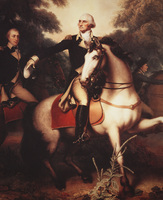 | Back to e-WV
| Back to e-WV
 The West Virginia Encyclopedia
The West Virginia Encyclopedia
 | Back to e-WV
| Back to e-WV
 The West Virginia Encyclopedia
The West Virginia Encyclopedia

At the age of 16, George Washington (February 22, 1732–December 14, 1799) ventured for the first time into the mountainous regions that later became West Virginia. Washington learned surveying at an early age, and between 1748 and 1752 he helped to survey extensive tracts of land in the Fairfax estate, which included the present Eastern Panhandle and Potomac Highlands. Compounding his income by purchasing land, he came to own more than 2,300 acres by age 20, including lands in present West Virginia.
Washington began his military career at a time in which the Appalachian interior of North America had become a battleground of France, England, and various Indian nations. As commander of Virginia militia charged with defense of the frontiers, including the present Eastern Panhandle, Washington attacked a French party before the official onset of hostilities and thus helped to bring on the global conflict known as the French and Indian, or Seven Years War. His later heroism at the defeat of General Braddock near present Pittsburgh in July 1755 helped save British forces from complete destruction. As colonel of the Virginia Regiment from 1755 to 1758, Washington rose to the highest military office in Virginia before age 25. He sought to defend the western reaches of the colony with a string of forts stretched along the Appalachian Mountains, including Forts Edwards, Pearsall, and Seybert in present Hampshire and Pendleton counties.
In 1758, Washington gave up the command of the Virginia Regiment and temporarily retired to a planter’s life at Mount Vernon and marriage to Virginia’s wealthiest widow, Martha Dandridge Custis. During a decade spent largely in the west, he had fulfilled much of his youthful ambition for wealth and reputation. He never forgot the area and traveled there whenever possible to view his land-holdings, which ultimately exceeded 50,000 acres in the region, or to ‘‘take the waters’’ at Berkeley Springs. Following the French and Indian War, Washington acquired extensive lands in present West Virginia, on the Ohio River, Kanawha River, and elsewhere. In 1770, he traveled down the Ohio to view these lands and seek others.
For both personal and political reasons Washington continued to pursue the improvement and development of western lands. To open the Potomac River to commercial navigation, he helped found the Potomac Company and promoted the work of steamboat developer James Rumsey. Placing the interests of the United States above the welfare of both native peoples and American settlers in the west, President Washington concluded numerous treaties with Indian nations and used military force to suppress political unrest during the Whiskey Rebellion. Washington understood the west and its role in the emerging nation better than most of the founding generation of political leaders, and he established the first U.S. Armory at Harpers Ferry. Numerous Washington family members took up family lands in what is now the Eastern Panhandle, where their homes and properties remain landmarks today.
Written by Warren R. Hofstra
Freeman, Douglas Southall. George Washington: A Biography 5 vols. New York: Charles Scribner's Sons, 1948-1957.
Hofstra, Warren R., ed. George Washington and the Virginia Backcountry. Madison, WI: Madison House, 1998.
Lewis, Thomas A. For King and Country: The Maturing of George Washington, 1748-1760. New York: Harper Collins, 1993.